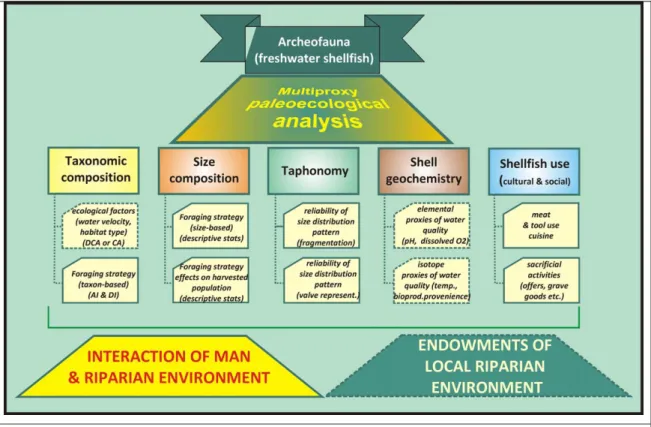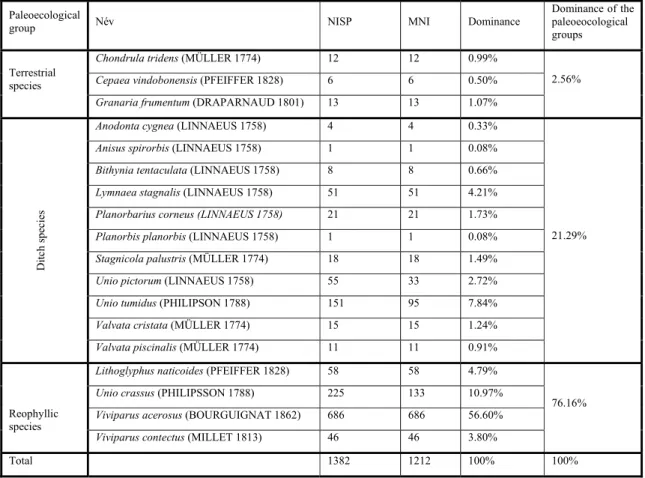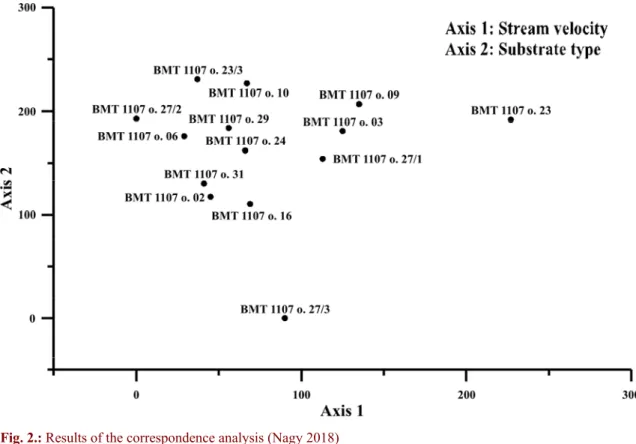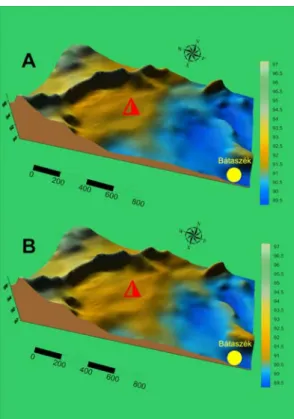PALEOENVIRONMENTAL RECONSTRUCTION OF THE ALSÓNYÉK-BÁTASZÉK STARČEVO SITE
USING ARCHEOMALACOLOGICAL DATA
ALSÓNYÉK-BÁTASZÉK STARČEVO LELŐHELY ŐSKÖRNYEZETI REKONSTRUKCIÓJA ARCHEOMALAKOLÓGIAI ADATOK ALAPJÁN
NAGY, Balázs1*; GULYÁS, Sándor1; SÜMEGI, Pál1
1 Szegedi Tudományegyetem, Földtani és Őslénytani Tanszék, 6722 Szeged Egyetem u. 2.
E-mail: nagba88@gmail.com
Abstract
From 2006 rescue excavations near Bátaszék SW Hungary revealed the presence of numerous archeological features dated to the Neolithic. This work presents the findings of archeomalacological investigations implemented at the Department of Geology and Paleontology, University of Szeged on samples from Starčevo feature. These studies included the taxonomic determination of the recovered mollusk taxa, size distribution analysis as well as geochemical analysis of freshwater shells. The studied material yielded 1382 individuals of 18 taxa (11 freshwater snails, 4 mussels and 3 terrestrial snails). Most of the examined freshwater species are characterized by a preference for moving-water conditions, while a smaller proportion was preferring standing water or temporary moving water conditions. Based on our findings, a more versatile use of the floodplain characterized by dominantly moving-water conditions may signal increased flooding preceding the time of site abandonment similarly to coeval Körös culture sites in the Middle Tisza region.
Kivonat
A Tolna megyei Bátaszék határában a 2006-tól a megelőző ásatások során több, a neolit korhoz is kapcsolható kultúra maradványait tárták fel. A Starčevo kultúra malakológiai leletanyaga a Szegedi Tudományegyetem Földtani és Őslénytani tanszékén került feldolgozásra. A vizsgálatok magukba foglalták a kagyló és csigahéjak taxonómiai meghatározását, a magassági és szélességi értékek meghatározását, méreteloszlásvizsgálatot és geokémiai vizsgálatot. Az 1382 mintából 18 fajt sikerült azonosítani, melyből három volt szárazföldi csigafaj, 11 vízi csigafaj és 4 kagylófaj. A vizsgált édesvízi fajok nagy többsége áramló környezethez, míg a kisebb hányaduk a lassú áramlókörnyezhez vagy az állóvízhez köthető fajok voltak. Az archeomalakológiai és héjgeokémiai eredmények alapján kijelenthető, hogy mai dunai viszonyokhoz képest a begyűjtés egy eltérő hidrodinamikai rendszerben történhetett. A kapott eredmények alapján kijelenthető, hogy a Starčevo-telep felhagyását megelőzően a környező árteret döntően mozgóvízi körülmények jellemezték, mely intenzívebb áradásokra utalhat. Hasonló változások voltak megfigyelhetőek a Tisza vidékén levő ugyanolyan korú Körös lelőhelyeken is.
KEYWORDS: MOLLUSKS,NEOLITHIC,STARČEVO CULTURE, PALEOENVIRONMENT RECONSTRUCTION
KULCSSZAVAK: PUHATESTŰEK, NEOLITIKUM,STARČEVO-KULTÚRA, KÖRNYEZETI REKONSTRUKCIÓ
Introduction
The region of the Carpathian Basin was occupied by three Neolithic cultural groups - Körös, Starčevo, Criş - from the 6th millennia BC. This is an important phase in human history, as this period witnessed one of the largest economic and cultural transformations, the spread of agriculture, which replaced the former hunting-gathering lifestyle (Kalicz 1990).
One of the main advantages of agriculture is the stable produce, but in periods of crisis, when there is crop failure or the output is not enough, alternative food sources are also included in subsistence like fish or shellfish. Multivariable archeomalacological studies can help us identify the role of these secondary resources in subsistence with potential underlying causes (Gulyás 2011; Gulyás and Sümegi 2012). This study presents the results of such investigations at one of the Early Neolithic sites in the Mid-Danube valley near Bátaszék, SW Hungary.
How to cite this paper: NAGY, B. et al., (2019): Paleoenvironmental reconstruction of the Alsónyék-Bátaszék Starčevo site using archeomalacological data, Archeometriai Műhely XVI/3 167–174.
Fig. 1.: The steps of multiproxy paleoecological analysis (Gulyás & Sümegi 2011) 1. ábra: A többtényezős paleoökológiai elemzés lépései
Study area
The studied shells came to light from the south-east area of an excavation site found near Bátaszék:
Bátaszék-Mérnökségi Telep. The city Alsónyék, Bátaszék located in Tolna country, SW Hungary, in the Tolnai-Sárköz micro-region. A substantial part of the surface is covered with the Pannonian/Holocene muddy substrate of Danube.
(Dövényi 2010). Before the river regulations most of the area was part of the floodplain of the Danube and its small tributaries.
Archeological excavations lasted from 2006 to 2009. The entire site has an estimated extension of ca. 80 hectares, of which only ca. 25 hectares (254.417 m2) have been systematically excavated (Osztás et al. 2016: p. 18). The number of excavated features was 15,443, from which 10.191 are from the Neolithic. In our study site excavations began in 2008. Here out of the 2.911 features 2.401 was Neolithic. Besides the 72.470 ceramic fragment and 30.914 animal bones (Osztás et al. 2016: p. 18) 25 human remains have been encountered dated to this period (Köhler 2015: p. 4).
Starčevo culture
Representatives of the Starčevo culture occupied the region of Transdanubia south of Lake Balaton from the 6th millennia BC. The coeval Körös and Criş cultures are found east of the Danube. The Starčevo culture created the first burned pottery in Transdanubia. Our studied settlements are found on a long ridge of larger streams and rivers. With time agriculture (einkorn wheat, emmer wheat, barley) and animal husbandry (cattle, sheep, goat, pig) got continually bigger emphasis. In the middle of the 6th millennia the emergence of the Central European Linear Pottery culture (LBK) in the Carpathian Basin led to the disappearance of the Starčevo culture. (Kalicz 1990)
Material and methods
In this study we followed the multiproxy paleoecological analysis (Fig. 1.) presented in Gulyás (2011) and Gulyás & Sümegi (2011, 2012a) for freshwater shells with a slight change. This enabled us to compare our results with those of other studied coeval sites. The purpose of the analysis is to highlight human environment interactions in riparian environments as well as the importance of second-line food resources.
The first step is the identification of taxonomic composition, if possible, at the species level. This is followed by the determination of minimum number of individuals (MNI) (Grayson 1978). This is then used to calculate the relative abundances of the identified taxa for each sample (Cannon 2001).
Shannon diversity index (1949) provides information on taxon-specific foraging (Gulyás &
Sümegi 2012a; Peet 1974). Higher diversity means the inclusion of more taxa in the harvested fauna;
i.e. species with low economic value.
By applying correspondence analysis to a taxon abundance data matrix, with taxa in columns and samples in rows it is possible to investigate the complex taxonomical composition of the samples considering the environmental demand of the individual species as well (Gulyás & Sümegi 2012a). In this method the sample number and the individual numbers matrix can be described as a multi-dimensional space, which is transformed into a "theoretical ecological space", into a reduced one- dimensional space. In this space each species occupies a point corresponding to its ecological demands. Eigenvalues from each axis are interpreted as a background variable, which presents how the frequency of species with different ecological demands varies in the local ecological space.
The next step involves the description of size. Shell height and width was recorded on valves of mussels belonging to the group of Unionidae and freshwater snails of the Viviparidea family. Using univariate statistical descriptors (average, median, variance, skewness, kurtosis, range) we can get an overview of the age and size distribution of the fauna; in other words the demographic composition (Gulyás
& Sümegi 2012a).
The following investigation involves detection of any signs of alteration of the shells carrying information on the utilization. Ash-brown shells indicate roasting before consumption.
Geochemical investigations provide information on the bioproductivity and volume changes of waterbodies of the surrounding freshwater habitats from which the mollusks derive. Because of their filtrating lifestyle, shellfish integrate trace elements into their shells in the same concentration as in their environment (Ravera et al. 2003; Gulyás & Sümegi 2012a). There is a strong correlation between the measured manganese concentrations and bioproductivity (Langlet et al. 2006). Green-algae
are able to include manganese in large quantities in their bodies (Sunda & Huntsman 1985), which is released after their death into the water. However, a high degree of bioproduction requires a large amount of oxygen consumption, therefore, the higher manganese content in the shells indicates smaller dissolved oxygen content. Due to the significant use of oxygen, the reduction of iron and manganese lowers the pH of the water (Richardson et al. 1988). Since the water solubility of Fe2+, Co2+
and Zn2+ is highly pH dependent (Stumm &
Morgan 1996), we can get an understanding of the changes in the pH conditions of the water based on concentration values recorded in our shells.
Geochemical investigations have been performed on a total of 69 specimens, of which 33 (24 pcs Unio crassus, 9 pcs Unio tumidus) originated from Sample 27, 10 from Sample 2 (10 pcs Viviparus acerosus). In addition 26 specimens (8-8 pcs Unio crassus and Unio tumidus, 10 pcs Viviparus acerosus) derive from the modern Danube near Baja (Nagy 2018). Manganese, iron and zinc content of the shells were determined after wet digestion using the flame AAS technique (Perkin Elmer A10 AAS). To determine if the individuals came from one or more places, a Kruskal-Wallis test on the results was implemented.
Results
A total of 14 samples were investigated containing 1382 pcs (Tab. 1) of identifiable individuals. The samples were taken from a refuse pit, object 1.107.
From the identified 18 taxa Viviparus acerosus (BOURGUIGNAT 1862) (686 pcs) was the most frequent followed by Unio crassus (PHILIPSSON 1788) with 225 pieces and Unio tumidus (PHILIPSON 1788) with 151 shells (Nagy 2018:
27-46. p.). 9 samples were dominated moving- water species, while in five samples the dominance of stagnant water or slowly moving-water species was typical.
It is already apparent from these data, the environs around the site were constantly changing, and different aquatic environments were targeted. The results of correspondence analysis also led to similar conclusions (Fig. 2.). Note that sample 27/3 is separated from other samples because of the small number of individuals. On Fig. 2. Axis 1 must represent stream velocity, while Axis 2 substrate type. Positive eigenvalues on Axis 1 correspond to higher velocities. Positive values on Axis 2 represent sandy substrates.
Table 1.: List of the identified species (Nagy 2018) (NISP: Number of the identified specimens, MNI: Minimum number of individuals)
1 táblázat: Azonosított fajok listája (NISP: teljes felismert példányszám, MNI: legkisebb becsült egyedszám)
Paleoecological
group Név NISP MNI Dominance
Dominance of the paleoeocological groups
Chondrula tridens (MÜLLER 1774) 12 12 0.99%
Cepaea vindobonensis (PFEIFFER 1828) 6 6 0.50%
Terrestrial species
Granaria frumentum (DRAPARNAUD 1801) 13 13 1.07%
2.56%
Anodonta cygnea (LINNAEUS 1758) 4 4 0.33%
Anisus spirorbis (LINNAEUS 1758) 1 1 0.08%
Bithynia tentaculata (LINNAEUS 1758) 8 8 0.66%
Lymnaea stagnalis (LINNAEUS 1758) 51 51 4.21%
Planorbarius corneus (LINNAEUS 1758) 21 21 1.73%
Planorbis planorbis (LINNAEUS 1758) 1 1 0.08%
Stagnicola palustris (MÜLLER 1774) 18 18 1.49%
Unio pictorum (LINNAEUS 1758) 55 33 2.72%
Unio tumidus (PHILIPSON 1788) 151 95 7.84%
Valvata cristata (MÜLLER 1774) 15 15 1.24%
Ditch species
Valvata piscinalis (MÜLLER 1774) 11 11 0.91%
21.29%
Lithoglyphus naticoides (PFEIFFER 1828) 58 58 4.79%
Unio crassus (PHILIPSSON 1788) 225 133 10.97%
Viviparus acerosus (BOURGUIGNAT 1862) 686 686 56.60%
Reophyllic species
Viviparus contectus (MILLET 1813) 46 46 3.80%
76.16%
Total 1382 1212 100% 100%
Manganese concentrations in most of the Unio crassus shells from Sample 27 varied between 100 and 250 ppm. Similar values are reported by Bába et al. (2002) from modern Tisza specimens and Ravera et al. (2003) from specimens of an Italian lake. It must be noted though that these measurements were made on a shell of a different taxa. Measurements on samples from the Körös sites of Ecsegfalva 23B, Tiszapüspöki and Nagykörű-Gyümölcsös (Gulyás 2011) were done on representatives of the same taxa as ours, and values are comparable. (Table 2.) Low manganese concentrations indicate a lower rate of bioproduction, higher dissolved oxygen levels of the waterbodies found on the floodplain; i.e. higher freshwater supply with a higher water velocity. This also implies the presence of a highly unstable riparian environment, where water supply and flow conditions changed continuously (Gulyás &
Sümegi 2012b). According to the Kruskal-Wallis test on the measured values, the samples must derive from the same habitat (P=0.35387, P=0.225343 without recent samples).
Concentrations of zinc in Unio crassus shells yielded similar results to those of the sites listed above. However, the standard deviation is very high here. It may also indicate that the individuals derive from a habitat where pH conditions are very diverse (Gulyás & Sümegi 2012b). Kruskal-Wallis test shows a significant difference between the samples (P=0.000605231; without recent samples P=0.00323383), so the collection may have targeted different habitats. Concentrations of zinc in Unio crassus shells yielded similar results to those of the other sites listed above. However, the standard deviation is very high here. It may also indicate that the individuals derive from a habitat where pH conditions are very diverse (Gulyás & Sümegi 2012b). Kruskal-Wallis test shows a significant difference between the samples (P=0.000605231;
without recent samples P=0.00323383), so the collection may have targeted different habitats.
Fig. 2.: Results of the correspondence analysis (Nagy 2018) 2. ábra: A korrespondencia analízis eredménye
Table 2.: Mn and Zn concentration in mussels (U.c.: Unio crassus, U.t.: Unio tumidus, U.p. Unio pictorum) (after Nagy 2018, edited)
2. táblázat: Kagylók Mn és Zn koncentrációi (U.c.: Unio crassus, U.t.: Unio tumidus, U.p. Unio pictorum)
In the case of Unio tumidus, the manganese content is slightly higher than that of Unio crassus. This may indicate a lower oxygen supply and a stable environment. These values are similar to measured data from Hungary and Europe. According to the Kruskal-Wallis test (P=0.196703; P=0.45198 considering the recent samples) there is no significant difference, so they come from the same habitat.
The standard deviation of the measured zinc content is very high indicating large-scale changes of the pH of the habitat. According to the Kruskal- Wallis test (P=0.0152741; without recent samples P= 0.020134), the collection of individuals could have happened from different habitats. The values are similar to the data from other sites in Hungary and Europe.
Sample 27 Nagy 2018: p. 51
Bába et al.
2002: p. 44
Ravera et al.
2003: p. 65
Ecsegfalva 23B Gulyás 2011:
p. 52-53
Tiszapüspöki Gulyás 2011:
p. 60-61
Nagykörű- Gyümölcsös Gulyás 2011:
p. 69-70
Mn U.c.: 214.4 ppm U.t.: 236.6 ppm
U. t.: 226 ppm;
U. p.: 166 ppm U.p.: 220 ppm U.c.: 216 ppm U.c.: 110-320 ppm U.c.:
157-370 ppm
Zn U. c.: 18.6 ppm U. t.: 17.2 ppm
U.t.: 11.17 ppm;
U. p.: 26.25 ppm U.p.: 19 ppm U.c.: 17-21 ppm U.c.: 12-13 ppm U.c.:
15-35 ppm
Fig. 3.: Scorched mussel shells (Nagy 2018, edited)
3. ábra: Megperzselődött kagylóhéjak
The low manganese content of the Viviparus acerosus shells from Sample 2 (average 56.3 ppm) indicates good oxygen supply and rapid water movement. Recent specimens yielded higher values (average 80.4 ppm), i.e. the two environments were different based on the manganese content, which is also supported by the Kruskal-Wallis test (P=
0.000155268). The amount of zinc in the archaeological specimens ranges on a wide scale (17-29 ppm), which may refer to the large-scale changes of pH. According to the results of the Kruskal-Wallis test, (P=0.272493) the samples must derive from similar habitats.
Some of the shells were ash-brown displaying signs of burning (Fig. 3.) (samples 6 and 24). This may imply roasting before consumption. Alternatively, mussel meat could have been used as fodder too (Fűköh 2007, Sümegi et al. 2011).
Conclusion
Based on our findings it is possible to distinguish a period characterized by a higher water velocity, high freshwater supply when mollusks were collected from the drainage channels (Fig. 4.).
After this period of intensified flooding more stable conditions emerged when the collection occurred in larger puddles and small ponds (Nagy 2018).
Studies at sites of similar age (Gulyás 2011; Gulyás
& Sümegi 2012b) show a similar picture. Flooding and tranquil periods also changed around the Tisza settlements. The area of Bátaszék-Mérnöki Telep was abandoned during the late 6th millennium BC.
The following settlement of the LBK-Culture (Linearbandkeramik or Linear Pottery Culture) is recorded after a ca. 160-310-year gap (Bánffy et al.
2016).
Fig. 4.: The environs of the excavation site (triangle) during floods (A) and after floods (B) (after Nagy 2018, edited)
4. ábra: A feltárás (háromszög) környéke árvizek idején (A) és az árvízek levonolása után (B) Based on our findings, a more versatile use of the floodplain characterized by dominantly moving- water conditions may signal increased flooding preceding the time of site abandonment.
Nevertheless, more data is needed to justify this assumption.
Acknowledgements
Research has been carried out within the framework of University of Szeged, Interdisciplinary Excellence Centre, Institute of Geography and Earth Sciences, Long Environmental Changes research Team. Support of the Ministry of Human Capacities, Hungary grant 20391- 3/2018/FEKUSTRAT is acknowledged.
Bibliography
BÁNFFY, E., OSZTÁS, A., OROSS, K., ZALAI- GAÁL, I., MARTON, T., NYERGES, É. Á., KÖHLER, K., BAYLISS, A., HAMILTON, W., WHITTLE, A. (2016): The Alsónyék story:
Towards the history of a persistent place. Bericht der Römisch-Germanischen Kommission 94 283–
318 p.
BÁBA K., SÁRI D., TÓTH T. (2002):
Kagylócönózisok különböző aljzaton. A 2000. évi nehézfémszennyezés. Soosiana 23/30 37–48. p.
CANNON, M. (2001): Archaeofaunal Relative Abundance, Sample Size, and Statistical Methods.
Journal of Archaeological Science 28 185–195.
DÖVÉNYI, Z. (2010): Magyarország kistájainak katasztere. MTA Földrajztudományi Kutató Intézet.
Budapest. 102–107.
FŰKÖH, L. (2007): Mészvázba zárt információk.
Archeometriai Műhely IV/1 7–12.
GULYÁS, S. & SÜMEGI, P. (2011): Farming or foraging? New environmental data to the life and economic transformation of Late Neolithic tell communities (Tisza Culture) in SE Hungary.
Journal of Archaeological Science 38 3323–3339.
GULYÁS, S. (2011): Az édesvízi kagylók szerepe a kárpát-medencei neolit közösségek gazdálkodásának és az ártéri, folyóvízi környezet
lokális, regionális adottságainak rekonstrukciójában. Doktori értekezés. Szegedi Tudományegyetem. 182 p.
GULYÁS, S. & SÜMEGI, P. (2012a): The reconstruction of past hydrologies of the river Tisza using multivariable archeomalacological analysis.
In: GEIGER J., PÁL-MOLNÁR E., MALVIČ T.
szerk., New horizons in Central European geomathematics, geostatistics and geoinformatics.
SZTE Földrajzi és Földtani Tanszékcsoport, Szeged GeoLitera 113–131.
GULYÁS, S. & SÜMEGI, P. (2012b): Édesvízi puhatestűek a környezetrégészetben. SZTE Földrajzi és Földtani Tanszékcsoport, Szeged GeoLitera 165 p.
GRAYSON, D. (1978): Minimum Numbers and Sample Size in Vertebrate Faunal Analysis.
American Antiquity 43 53 p.
KALICZ N. (1990): Frühneolithische Siedlungsfunde aus Südwestungarn. Quellenanalyse zur Geschichte der Starčevo-Kultur. Inventaria Praehistorica Hungaria. 4 Magyar Nemzeti Múzeum, Budapest, 164 p.
KÖHLER, K. (2015): A Starcevo kultúra embertani leletei Alsónyák-Bátaszék lelőhelyről. Anthropoló- giai Közlemények 56 3–26.
LANGLET, D., ALLEMAN, L.Y., PLISNIER, P.D., HUGHES, H., ANDRÉ, L. (2006): Mn seasonal upwellings recorded in Lake Tanganyika mussels. Biogeosciences Discussions 3 1453–1471.
NAGY, B. (2018): A kora neolit Alsónyék-Bátaszék lelőhely puhatestű faunájának előzetes archeomalakológiai vizsgálati eredményei.
Diplomamunka. Szegedi Tudományegyetem 69 p.
OSZTÁS, A., BÁNFFY, E., ZALAI-GAÁL, I., OROSS, K., MARTON, T., SOMOGYI, K. (2016):
Alsónyék-Bátaszék: introduction to a major Neolithic settlement complex in south-east Transdanubia, Hungary. Bericht der Romisch- Germanischen Kommission 94 7–21.
PEET, R. (1974): The Measurement of Species Diversity. Annual Review of Ecology and Systematics 5 285–307.
RAVERA, O., CENCI, R., BEONE, G.M., DANTAS, M., LODIGIANI, P. (2003): Trace element concentrations in freshwater mussels and macrophytes as related to those in their environment. Journal of Limnology 62 61–70.
RICHARDSON, L., AGUILAR, C., NEALSON, K. (1988): Manganese oxidation in pH and O2
microenvironments produced by phytoplankton.
Limnology and Oceanography 33 352–363.
STUMM, W.M., MORGAN, J.J. (1996): Aquatic chemistry. John-Wiley. New York. 366 p.
SUNDA, W.G., HUNTSMAN, S.A. (1985):
Regulation of cellular manganese and manganese transport rates in the unicellular alga Chlamydomonas. Limnology and Oceanography, 30 71–80.
SÜMEGI P., KOZÁK, J., TÓTH, Cs. (2011): A Tiszapolgár-Kenderföld bronzkori tell kagyló- anyagának táplálkozásbiológiai (paleozoológiai) feldolgozása. Archeometriai Műhely VII/2 197–
208.



